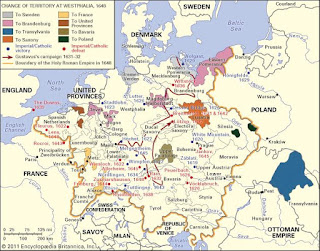The Thirty Years War
1555. Martin Luther has been dead for nine years, but the score has not been settled between the Lutherans and the Catholic Church. In particular, the Schmalkaldic League, a group of pro-Lutheran princes within the discombobulated wreck of a state known as the Holy Roman Empire, had, in 1547, been smashed by the pro-Catholic forces of Charles V, the Holy Roman Emperor. But the Lutherans had one particular superweapon - the printing press, which had resulted in the spread of Protestant ideals throughout Europe. As a result, the peace of Augsburg was signed in 1555, which allowed rulers of the various states within the Holy Roman Empire to chose between Lutheranism and Catholicism. For around 50 years, this seemed to be the correct solution - religious wars in Central Europe had finally ended, and peace seemed to be at hand. Yet, below the surface, a deep division was fermenting - in the south (modern day Austria, Northern Italy, and Bavaria), Catholicism stayed in power. In the north (the remainder of Germany), rulers gradually converted to Lutheranism.
This division exploded in 1618, with a spark now known as the defenestration of Prague. Catholic officials, complaining about the construction of protestant chapels,were hurled out of a window by Bohemian (modern day Czech Republic) land-owners. Tensions flared, and news spread rapidly. The death of the Holy Roman Emperor Matthias, a relative moderate, and his replacement by the strongly pro-Catholic Ferdinand II was the last straw. Fighting gradually escalated over the next two years, and in November of 1620, Catholic forces won a decisive victory during the first major battle of the 30 years war. While this ended the revolt in Bohemia, the war was far from over. A few months later, Spanish forces invaded the Protestant-controlled Palatinate, and won after a year of brutal fighting.
However, this Catholic tide was viewed with fear across the rest of Europe. The Holy Roman Empire and Spain - the two Catholic powers in the 30 years war - were controlled by the Hapsburg dynasty. If the Hapsburgs were to crush Protestantism in the Holy Roman Empire, they could have potentially built up an extremely powerful state in Central Europe, which would have been able to crush countries like France, Denmark, and Sweden. Around 1625, the 30 years war ceased to be about religion, and instead evolved into a war between the Hapsburg dynasty and the rest of Europe.
Denmark was the first to take a shot at the Hapsburgs, supplying troops and funds to Protestants in northern Germany. In response, the Hapsburg forces marched north, besieging several Danish-held cities. However, the Hapsburgs were not able to take Copenhagen, Denmark's capital, and resigned themselves to signing the treaty of Lubeck, where Danish territorial integrity was preserved in exchange for Denmark promising not to aid the Protestants.
The Danish defeat garnered the attention of Sweden, led by its warrior-king, Gustavus Adolphus. Alarmed by the growing strength of the Hapsburgs, Adolphus invaded Germany in 1630, using Pomerania as a springboard to drive Swedish forces deep into the Holy Roman Empire. A combination of excellent leadership on behalf of Adolphus, as well as the enlistment of several thousand German mercenaries put the Catholics on the defensive for five years. In 1635, however, the peace of Prague was signed, which ended the "civil war" aspect of the 30 years war, with the Holy Roman Empire negotiating a peace with the Lutheran princes. The exact reasons for this peace are subject to debate, but overall, it appears to have come about as a result of a common desire to halt foreign intervention, which had been incredibly destructive for most of Central Europe. This peace marked another very important point in history - national interests had trumped religion, and there was essentially a mutual recognition that fighting over religious differences was ultimately unfeasible.
The peace of Prague only further unsettled the rest of Europe, who now viewed the Hapsburgs as one step further to consolidating power in Central Europe. In 1635, the Catholic-led France (who had been aiding Sweden in its war) declared war on the Holy Roman Empire, essentially ending the concept of basing foreign policy off of religion. Initial French efforts were disastrous, but by 1640, the French had started pushing into Flanders and parts of Germany. France also funded anti-Spanish rebels in Portugal, diverting many Spanish troops away from the main conflict and into Iberia. In 1643, the French won at Rorcoi, and in 1645, Swedish forces reached almost as far south as Vienna.
Nevertheless, both sides were facing huge problems. The Hapsburgs had been fighting for 30 years, and the Holy Roman Empire had been destroyed by the fighting. Sweden was vastly over-extended, while France was facing the Fronde, a serious of internal rebellions led by the nobility against King Louis XIV. The warring powers signed a series of peace deals in 1648, known as the peace of Westphalia. Officially, Westphalia granted the Netherlands independence from Spain, re-affirmed the peace of Augsburg (and extended it to Calvinists), and granted France and Sweden various territories. Unofficially, the peace of Westphalia marked the end of religion in foreign affairs, and also established the precedent that no single nation or family should dominate Europe - a precedent enforced when the Bourbon dynasty attempted to take Spain, when Napoleon invaded all of Europe, and when German attempts at domination were thwarted in World War I and World War II.
In the short term, the Thirty Years War killed 8 million people and decimated the economy of Europe. Over the next several hundred years, the precedents established by Westphalia created countries, instigated numerous wars, and changed the nature of governance. The vital lesson that
national leaders can take from Westphalia is simple - national interest trumps all in foreign policy. To ignore this lesson is to ignore the nature of international relations.



Comments
Post a Comment